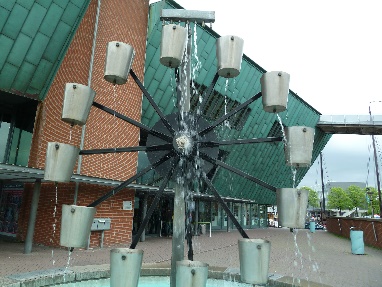Feature 1, temporal irregularity
The following video provides the answer to question B of Section I.
We see the motion of a ruler, fixed to an axis moved by the the action of an electric wiper motor. In the language of physics: this is a pendulum driven by the periodically moving suspension point (with a period of about 1.2 s) in the horizontal plane. Schematically:
Can you say, having watched the video for some time, the direction the ruler will rotate next (clockwise or counter-clockwise)?
The motion is rather strange (and funny). It is long lasting without any tendency to come to a rest (due to the energy input coming from the motor which compensates on average the action of friction), but the rotation was seen to have stopped in both a vertical and a tilted position for a moment. After these unstable states rotation can reemerge in any direction. The overall irregular character is the reason why we call such motions chaotic. Note that this scientific term has a meaning different from the every-day use in which chaos typically means spatial disorder. For a distinction, the term deterministic chaos can be used when we speak of motions with irregular temporal properties.
Returning to the photograph in question B, here is a video of the same system taken in darkness, when only the green led at the end of the ruler is lit.
Nowadays easily accessible technologies make possible that besides visual observation quantitative data can also be gained from the motion. We can measure, e.g., the velocity of the ruler as a function of time over long periods of time as this video illustrates:
The finding reinforces our first impressions: the function goes up and down, changes sign quite often, but is very much different from a cos or sin function. It has no recurrent piece, is not periodic at all! Following it for some time, one cannot imagine how it will be continued in the next seconds. This is a basic feature of any chaotic motions.
If you are interested in the raw data gained from the sensor, click here.
Another chaotic system: A home-made water wheel containing 12 small plastic coffee cups on a tilted disk which is able to rotate is another surprising set-up video. The driving force is here water flowing from a tap with constant speed. Although there is no time-dependence in the drive, again it is not possible to predict for how long the wheel is going to rotate in one or in the other direction. The pattern of the motion does not repeat itself, not even for long runs. This wheel was built by a secondary school student. Bigger devices can be seen in science centers.
Based on these observation, try to give an answer to the question: what is chaos?
Chaos is a long lasting motion of relatively simple systems, which is
- irregular in time, truly aperiodic, and is not the superposition of periodic components
There is nothing strange in the motion of an ordinary pendulum: it swings periodically (as long as air drag and friction is negligible.) Making the suspension point moving periodically have altered the character of the motion radically. What do you think, is it typical that when a system exhibiting regular motion is slightly modified, the dynamics becomes chaotic?
Yes, pendula with recurrently moving suspension point in any direction are chaotic, and the bounces of a ball on a vertically oscillating plate is also chaotic. Chaos is thus more general than regular motion.
Elements of chaos can be observed in every-day life, but these are often not long-lasting, and cannot be called, therefore, chaotic in a strict sense.
